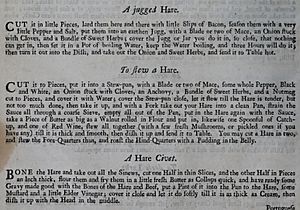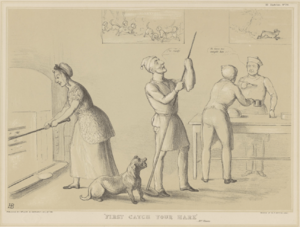Jugging facts for kids
Jugging is a special way of cooking food, usually wild animals like game or fish. It means you cook the whole animal slowly in a tightly closed pot or a tall jug. This cooking method makes the meat very tender and flavorful. In France, a similar dish made with game is called a civet.
Contents
Jugged Hare: A Classic Dish
One very old and traditional dish made using this method is jugged hare. It's a stew made from a hare, which is a bit like a large rabbit. The hare is cut into pieces, soaked in a special liquid (marinated), and then cooked slowly with red wine and juniper berries.
The cooking happens in a tall jug that sits inside a larger pan of boiling water. This gentle heat helps the hare cook perfectly. Traditionally, the hare's own blood is added to the stew, often right at the end, along with port wine. This helps to thicken the sauce and give it a rich flavor.
The Famous "First Catch Your Hare" Saying
An important cookbook from the 1700s, called The Art of Cookery by Hannah Glasse, has a recipe for "A Jugged Hare." Many people believe this book starts with the famous words, "First, catch your hare."
However, this is actually a myth! Hannah Glasse's recipe really begins, "Take your Hare when it is cas'd..." To "case" a hare means to remove its skin, not to catch it. So, the funny saying about catching the hare first was added later, not by Mrs. Glasse herself.
Preparing the Hare for Jugging
To make jugged hare, it's best to use a freshly caught hare because you need its blood. After the hare is killed, its insides are removed. Then, it's hung upside down in a cool place, like a larder, for about a week. This allows the blood to collect in its chest.
The blood is then drained and often mixed with red wine vinegar. The vinegar stops the blood from getting thick and lumpy (coagulating). After that, the blood can be stored in a freezer until it's ready to be used in the stew.
Is Jugged Hare Still Popular?
Jugged hare used to be a very common dish in Britain. However, it's not as well-known today. In 2006, a survey found that only a very small number of young people (under 25) even recognized the name "jugged hare." Most of them also said they wouldn't want to eat it if it was offered to them! This shows how much food tastes and traditions can change over time.
Civet de Lapin: Rabbit Stew
Civet de lapin is another type of civet, but it's made with rabbit instead of hare. It's a popular dish, especially in the cuisine of Martinique, an island in the Caribbean.
Jugged Kippers: A Fishy Dish
Another traditional "jugged" dish, especially in the United Kingdom, is jugged kippers. Kippers are a type of smoked fish. For this dish, the heads and tails are removed from the kippers. Then, they are placed in a covered jug and cooked in boiling water.
Cooking kippers this way is often recommended because it helps to reduce their very strong smell, which some people don't like.
See also
 In Spanish: Civet para niños
In Spanish: Civet para niños



